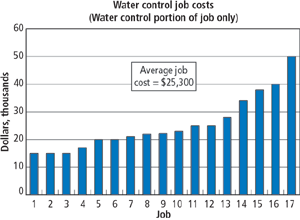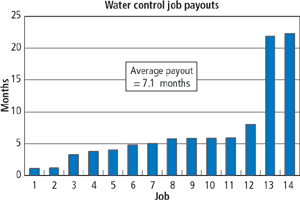|
| |
|

By Petroleum Technology Transfer Council |
Water control becomes economically attractive to L.A. basin operators
Facing ever-increasing water cuts and associated costs, Los Angeles basin operators pooled and analyzed data on dozens of wells to identify proven water control diagnostics and solutions. The effort confirmed positive results for practical, proven technologies, with payout averaging 7.1 months.
Ron Bates, Signal Hill Petroleum, Long Beach, California; Stan Brown, Brea Canon Oil, Torrance, California; Scott McGurk, Plains Exploration & Production, Los Angeles; Iraj Ershaghi, University of Southern California, Los Angeles; and Glenn Swanson, Consultant, Los Alamitos, California
While talking to producers, troubleshooters working with Petroleum Technology Transfer Council's (PTTC's) West Coast Region learned that excessive water production, and associated high lifting costs, had caused many mature wells or leases to be near or at the economic margin. The investigation was part of a special DOE-supported PUMP (Preferred Upstream Management Practices) project.
Lifting costs are exacerbated by California's power supply concerns and high electricity costs. In a project sponsored by the California Energy Commission that focused on further defining the water control problem and effective solutions, PTTC solicited producers willing to share data. Producers contributed data from seven fields in the Los Angeles (L.A.) basin, representing six waterfloods and one natural water drive. Together, these fields represent about 60% of L.A. basin output.
Data were summarized for 67 producers and 60 water injection wells with 12 different producing zones represented in the sample. Additionally, participants contributed information from 17 water control treatments performed on some of these wells. Data that were collected and analyzed included geologic information, well logs, completion information, production/ injection statistics and economic details.
To appreciate L.A. basin water production problems, one must understand the area's geologic and development history. Many fields have produced continuously since the 1920s and 1930s. Most have been waterflooded since the 1960s and 1970s. Producing reservoirs are thick, with alternating sand-shale sequences – many sands being wet from original conditions or continual waterflooding.
Shale layers can be discontinuous, and idle wells are numerous, so cross-flow between zones occurs easily. In typical completions, there are several sets of perforations and/or a slotted liner that cover 6 to 18 sub-zones, with a gross interval hundreds of feet thick. Shutting off unwanted water is further complicated by scarcity of information regarding volumetric production rates of water and oil by sub-zone.
Water control success stories have been few and far between. Many operators feel they are fighting problems in the dark with one hand tied behind their backs. They know they have a problem, but they don't know exactly how to solve it.
WATER CONTROL WORKOVER ECONOMICS
As noted, 17 water control workovers (often in conjunction with other work) were studied within the well sample. Cost information included total job figures, as well as water control-only costs, e.g., fishing and maintenance expenses were not considered to be water control expenses. Payouts for the water control portions of the job were calculated by multiplying total job payout time by the fractional cost of the water control work.
An average water control job cost of $25,300 is skewed by one workover costing $50,000, Fig. 1. Twelve of 17 water control workovers cost $25,000 or less. Of 14 jobs where the figure could be calculated, payout averaged 7.1 months, Fig. 2. Eleven jobs paid out in six months or less, which is attractive because benefits continue for a much longer term.
 |
Fig. 1. Average per-well water control cost was $25,000, but this figure was skewed by one workover that required $50,000 and two more jobs that approached $40,000.
|
|
 |
Fig. 2. Although average payout for water control was 7.1 months, a majority of the jobs paid out in less time.
|
|
SIGNAL HILL PETROLEUM
After 25-plus years of waterflooding, an Upper Brown (Lower Pliocene) well in Long Beach field produced increasingly problematic watercuts in excess of 98.5% (35 bopd, 2,351 bwpd). Fluid entry survey results showed that a major water entry of nearly 1,800 bwpd (with only a trace of oil) through the top 50 ft of perforations was likely holding back lower-interval potential. That potential included 200-plus ft of additional perforations spread out over 800 ft of gross interval.
Previous work on a nearby injector had redirected injection into lower sub-zones, so timing was ripe for a water shutoff workover on the producer. A $25,000, low-pressure squeeze job with ultra-fine cement successfully plugged the water zone. A fluid entry survey performed afterwards confirmed that oil was now produced from previously idle or under-produced sub-zones. Job payout was achieved quickly, given that post-job production was 64 bopd and 2,290 bwpd.
BREA CANON OIL
Torrance field's main zone (Upper Miocene) has been waterflooded since 1971, creating several known cycling cells between injectors and producers. Reservoir engineering homework, including use of production logging and injection profile surveys, indicated that certain high-water cut wells were likely producing the majority of fluid from the lower portions of their 250-to-350-ft, gravel-packed liner completions.
Cement plugs were placed over the water-producing intervals in five wells, resulting in four successes. Total production from the five wells before the workovers was 57 bopd and 8,763 bwpd (99.4% watercut). After the workovers, output was 83 bopd and 4,023 bwpd (98.0% watercut). Typical water control work cost $15,000 per well (as opposed to the $25,000 average in Fig. 1) and was paid out in less than six months.
PLAINS E&P
The Hauser zone (Upper Miocene) is the primary productive interval in East Beverly Hills field. One well experiencing water cycling from an injector was targeted for a 200-ft scab liner installation over existing perforations. Costing less than $30,000, this successful job paid out in less than four months because post-job production improved to 38 bopd and 562 bwpd (93.7% watercut) from pre-job rates of 20 bopd and 614 bwpd (96.9% cut).
Payouts in all water control projects must include saved water expenses. For example, a watercut reduction from 98% to 97% results in lifting cost reductions of $3.83/bbl, when water costs are $0.23/bbl (average for the study cited). Electricity costs associated with water lifting and re-injection comprised the largest portion (60+%) of this per-bbl cost.
DIAGNOSING PROBLEMS
Production logging surveys are the most direct method of tracking wellbore fluid movement. Injection profile surveys typically cost less than $1,000 and allow operators to observe which sub-zones take injected water. Fluid entry surveys usually cost less than $2,000 and produce reports containing quantitative water and qualitative oil production by sub-zone. As this consortium effort confirmed, both injectors and producers need to be surveyed to understand fluid flow within a waterflooded reservoir.
Tracer studies that track flow between injectors and producers have also been useful and cost-effective, with typical costs less than $10,000 for a pattern-sized project. Properly designed tracer work yields conclusions regarding which injectors and producers are in communication, as well as the length of time required for injected fluids to reach producers.
When fluid entry/ profile data are not available or practical, one can learn much from the shape of the water-to-oil ratio versus the time/ recovery curve. Embedded water intervals, post-breakthrough water and natural influx exhibit distinctively different shapes. When analyzed while reviewing the completion history, underlying problems can often be correctly diagnosed.
LIMITED DEMOS
Phase 2 of the consortium project is in its preliminary stages. Plans call for participants to submit requests for matching funds to pay for new water control diagnostic and/or workover projects. Two to three jobs in each category are targeted for completion, and subsequent analysis and reporting. 
ACKNOWLEDGMENT
Case study data were gathered and analyzed within the Water Control project receiving funding support from the California Energy Commission and the Petroleum Technology Transfer Council's (PTTC's) Preferred Upstream Management Practices (PUMP) project for the Department of Energy. This work was coordinated by Dr. Iraj Ershaghi, University of Southern California, who serves as PTTC's West Coast Regional Director. Author Glenn Swanson performed much of the project work on a consulting basis.
THE AUTHORS
|
| |
Ron Bates is the senior production engineer at Signal Hill Petroleum, where he manages all aspects of a 2,700-bopd waterflood. Prior to joining Signal Hill in 1987, He worked at Arco for 19 years, also in the Long Beach field, where he now has 30-plus years of experience. Areas of expertise include operations, reservoir and facility engineering. E-mail: rbates@shpi.net.
|
|
Stan Brown, P.E., is an independent consultant and chief engineer at Brea Canon Oil. His background features a BA degree from UCLA, an MS degree in petroleum engineering from the University of Southern California and 30-plus years of oilfield experience in many Southern California fields. His expertise includes all areas of production and reservoir engineering. E-mail: swbengr@adelphia.net.
|
| |
Scott McGurk is the engineering technical advisor at Plains Exploration & Production Co. in Los Angeles. Prior to joining Plains in 1997, he worked for Unocal and Exxon. He joined the latter firm upon completion of his BS degree in chemical engineering from Penn State University in 1977. His areas of expertise include all phases of reservoir engineering, including waterflooding, simulation, integrated studies and engineering databases. E-mail: smcgurk@plainsxp.com.
|
|
Iraj Ershaghi, Ph.D., is the Omar B. Milligan Professor of Petroleum Engineering at the University of Southern California, and he serves as PTTC's West Coast Regional Director. Prior to joining USC in 1972, he worked for Signal Oil and Gas and the California State Lands Commission. Throughout his career, he has been active in professional societies and academic groups, receiving many prestigious awards. E-mail: ershaghi@usc.edu.
|
|
Glenn Swanson, P.E., is an independent consultant and a principal in the start-up firm Encore Energy. His background features a BS degree in chemical engineering from Princeton University, an MS degree in petroleum engineering from University of Southern California and 25-plus years of oilfield experience. His areas of expertise include water control, stimulation, workovers, chemistry and project management. E-mail: swanglenn@aol.com.
|
|




